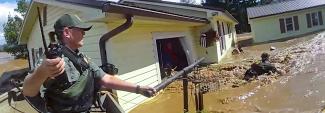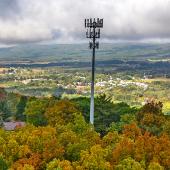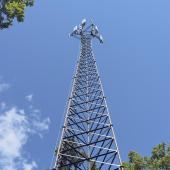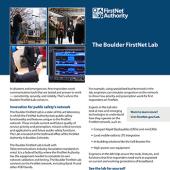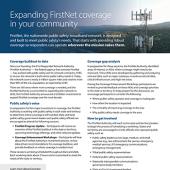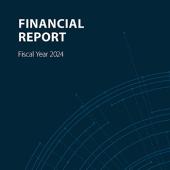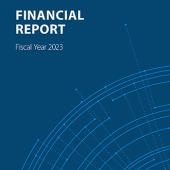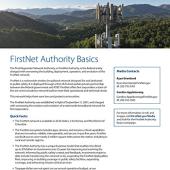This blog is a repost from MissionCritical Communications magazine, originally published on October 18, 2022.
This blog post is part of the "Tech Talk" series focused on the First Responder Network Authority’s (FirstNet Authority) standards development activities to support public safety. This post recaps discussions linked to public safety and other related topics from the 3GPP Plenary meetings that were conducted online in September 2022. The FirstNet Authority represented public safety interests at the Plenary meetings.
The latest set of Third Generation Partnership Project (3GPP) Plenary electronic meetings (e-meetings) concluded on September 19. The meetings focused on Release 18 (R18) which is currently in progress. R18 will become the inaugural release for 5G Advanced that includes new innovations toward the 5G vision. The plenary e-meetings made solid progress on the study items and work items that form the basis to advance the agreed upon R18 features. The following reports discuss the current status of R18 work.
About every two years, the plenary discusses feature content to include in the next release. For R19, significant discussion to start defining the "themes" or focus sets of features that could be included in R19 began. These "themes" provide the wireless community with an idea of the major features they might expect in the upcoming release. If 3GPP agrees to move forward with the proposed trial use of "themes" in R19, we can expect some definition of potential theme content in the first half of 2023.
In other developments, 3GPP is working on the return to in-person meetings. The June plenary held in-person meetings in Budapest, Hungary. Nearly all the working groups will be meeting in-person in Toulouse, France in November. The goal is to hold four in-person meetings and two e-meetings per year for each working group, depending on the groups' schedules, and at least two plenary in-person meetings in 2023.
The following Technical Specification Group (TSG) reports include details on each of the Plenary TSG e-meetings focused on progressing mission-critical (MC) R18 features important to public safety. Participation in 3GPP continues to grow with representatives from about 35 countries, including nearly all major mobile equipment vendors, chip manufacturers, software vendors, network operators, and several universities. The First Responder Network Authority (FirstNet Authority) and government agencies of other nations continue to represent public-safety interests.
As a background note for the TSG reports that follow, the work in a 3GPP release feature is typically done as a study phase first followed by a normative phase to create product standards. The study phase is coordinated by study item descriptions (SIDs) for each feature and the normative phase is coordinated by work item descriptions (WIDs).
The Radio Access Network (RAN) Plenary
Approximately 470 participants attended the TSG RAN September Plenary e-meeting. RAN is responsible for defining the requirements, functions, and interfaces of the 3GPP radio network.
The working group reports demonstrated good progress on R18 with the plenary approving several R18 SIDs and WIDs at the meeting. This sets the scope for R18 features. Of particular interest to public safety are:
- A SID for study on New Radio (NR) network-controlled repeaters (NCR) in-band radio frequency repeaters. A particular focus of this feature includes turning on or off NCR operation for efficient interference management. This feature will provide improved extension of network coverage on all spectrum bands compared to traditional repeaters and will be valuable for public safety.
- Support for reduced complexity of NR devices focusing on reduced bandwidth of 5 MHz in sub-6 GHz frequency bands (410 - 7125 MHz) as a new WID. These devices are also widely used for industrial automation and general environmental monitoring use cases such as monitoring of critical infrastructure (e.g., buildings, bridges, water dams) or monitoring natural disasters (e.g., wildfires, floods, tsunamis, earthquakes).
- A WID for sidelink evolution to focus on ensuring that LTE and NR devices coexist while using the same carrier frequency without negatively impacting the operation of each other. In a related SID for expanded and improved NR sidelink positioning, solutions for sidelink-only-based and a combination of the access link-based — the Uu interface between user equipment (UE) and a base station — and sidelink-based will be investigated. During this study, both in-coverage and out-of-coverage scenarios will be addressed to provide enhanced position determination solutions for public safety. These features will support public safety's need for off-network communications and positioning.
- A WID for mobile integrated access and backhaul (IAB) focuses on the scenario of mobile IAB nodes mounted on vehicles providing 5G coverage/capacity enhancements to onboard and/or surrounding mobiles (UEs). Mobile IAB is supported in all frequency bands for both access and backhaul. As discussed in previous blogs, IAB enables cost-effective deployments utilizing the same spectrum for both access and backhaul.
- A WID to support enhancements for NG-RAN-based non-terrestrial networks (NTN), such as satellites, for both Voice over Internet Protocol (VoIP) using Adaptive Multi-Rate (AMR) 4.75 kbps voice and 3 kbps data transmission services. This holds much promise for public safety in supporting UE to satellite communications in remote areas.
The group approved work on "Conformance Test Aspects - Protocol enhancements for MC Services" for R16, including mission-critical push to talk (MCPTT), mission-critical video (MCVideo) and mission-critical data (MCData), to develop required specifications to test these mission-critical services. This work will facilitate the implementation of these services for public-safety networks such as the FirstNet network built by AT&T.
The Service and System Aspects (SA) Plenary
Over 440 participants attended the TSG SA September Plenary meeting #97e, which is responsible for the overall architecture and service capabilities of 3GPP-based systems. As discussed in previous articles, the SA1 working group typically works one release ahead to define the requirements and use cases for new features, services and enhancements. SA1 continues to work on R19 requirements and is advancing work on 17 study items for R19. More features may be added before the R19 feature set is frozen. The working group made steady progress on R19 use case definitions and requirements on all active features and services of interest to public safety. These include Integrated Sensing and Communications that will allow the 5G system to work similar to radar by allowing the user to “see” remote objects without physical contact. This may benefit public safety in search and rescue (SAR) operations or tracking first responders in dense smoke or other environments where visibility may be limited.
The ambient-powered internet of things (IoT) devices R19 feature focuses on harvesting power from the surrounding environment (e.g., radio waves, solar, wind, vibration, heat), allowing for battery-less or limited storage devices. There are possible use cases for small sensors on fire and safety turn-out gear to allow tracking of personnel without concerns about recharging the sensor.
"Localized Mobile Metaverse Services" is another feature the group will study as potential new services based on extended reality (XR) that encompass both virtual reality (VR) and augmented reality (AR). The term metaverse is often used to refer to the broader implications of AR and VR, but for 3GPP it is used to refer to locally relevant, persistent, shared content accessed by both onsite and remote users. For example, metaverse services could provide more detailed views for first responders in a smoke-filled building. By combining all the perspectives and overlaying it with augmented reality scenes, the heads-up display inside the firefighter's helmet could show hallways, rooms, and the locations of other first responders. The same scene could be also sent to the incident commander to maintain and improve situational awareness.
The SA2 working group reported that R18 architectural studies are on average 80% completed, and some of the work items to begin R18 normative technical specifications have been submitted for approval. SA2 continued to report on the progress on high priority items for public safety including 5G proximity-based services (5G ProSe) enhancements to support UE-to-UE relay for extending the range of off-network communications, 5G multicast-broadcast services (5MBS) enhancements to support clusters of high numbers of public-safety UEs, vehicle mounted relay (VMR) to extend coverage, and location-based services enhancements and range-based services to improve situational awareness, as well as the ability to determine the location and direction of a public-safety UE.
The SA3 working group reported to the SA Plenary that the remaining R17 work areas have been closed as planned. A new secondary authentication feature in ProSe that had been originally targeted for Release 17 has been moved to R18 with no impact expected for current public-safety use cases. As a reminder, the SA3 security work in R17 provides a control plane-based security procedure, 5G ProSe communication via Layer-3 UE-to-network relay, additional details on the security of discovery procedures for UE-to-network relay, and details on the control plane-based secondary authentication procedures. All of these will directly benefit the security of public-safety personnel, especially in off-network communications.
Normative work for security features in R18 is advancing as expected, but progress on R18 security SIDs has been slow. It is expected that the transition back to in-person meetings will help to speed up the SA3’s work.
The SA6 working group reported that the 12 SIDs and 12 WIDs approved for R18 are all progressing. Considerable discussion continues on ad hoc group communications with debates on setting up and managing ad hoc groups. The FirstNet Authority supports additional enhancements for MCPTT, improved location services over 5G, enhancements to 5MBS, and mission critical services over 5G ProSe.
The Core Network and Terminals (CT) Plenary
Approximately 380 participants attended the TSG CT Plenary e-meeting, which covers the protocol details that follow the requirements and architectural work performed in the SA TSG The group spent the majority of time agreeing to fixes and text alignment for R17 features. The group also approved a number of R18 WIDs heralding the beginning of stage 3 protocol work on R18. Although the stage 2 architectural work for R18 continues in SA2 and SA6, some features are considered stable enough to allow the protocol work to begin. Stage 2 architectural work is scheduled to be completed by March 2023, with stage 3 protocol work to be completed by December 2023.
Regarding R18 MC features, we are closely watching and participating in work on behalf of public safety including further enhancements to location services, discreet listening and logging, users logged into multiple devices (e.g., phone and laptop), temporary mission-critical user identities, resolution of additional problems noted during development of tests in the 3GPP RAN5 working group and in European Telecommunications Standards Institute (ETSI) Plugtests, exchange of location information between LMR and 3GPP mission-critical systems, security enhancements, 5G ProSe over the 5G NR sidelink, 5G relay UE, and MC services over 5G. Many of these features enhance work already in R17, while some provide new functionality. The FirstNet Authority is working with other companies to plan this work to assure its successful completion.
Further information on the 3GPP’s work and organization can be found at www.3gpp.org.





